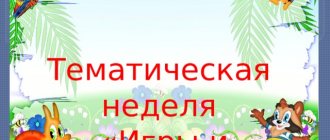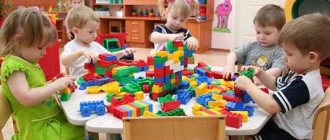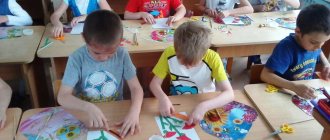Theater day in kindergarten. Middle group
Thematic day “WORLD THEATER DAY” for children 4-5 years old
Goal: Development of children's communication abilities through theatrical and play activities Objectives: To promote the development of the child's individual creative abilities and artistic inclinations; Arouse in children a sustainable interest in the theater; Cultivate friendly communication with each other; To form a sustainable interest in literature in children; Involve children in telling fairy tales Planning: 1. Conversation about the theater 2. Table theater “Mashenka and the Bear” 3. Physical exercise “We are in the theater of animals” 4. Game - concert “On the theater stage...” 5. Didactic game “Collect a fairy tale” 6 Showing the play by parents “Sister Alyonushka and Brother Ivanushka” 7. Drawing “My Favorite Fairy Tale” (joint creativity of parents with children) MORNING 1. CONVERSATION ABOUT THE THEATER Educator: There is a stage and backstage, And actors and actresses, There is a playbill and an intermission , Scenery, sold out. And, of course, the premiere! You probably guessed it... (theater)
- Today is World Theater Day.
- What is theater? (children's answers)
- What professions do people work in the theater?
(children's answers)
- Today you and I will be both actors and spectators.
I suggest you go to a fairy-tale place called “Theater”. — In order for you and me to go to the performance, we need to buy tickets. — Why do you need tickets at the theater? (children's answers) Children go to the ticket office and buy tickets.
— Before going to the auditorium, you need to remember the rules of behavior in the theater.
(children's answers)
- Listen, we are invited by a theater bell into the auditorium.
You need to have time to take your seats in the auditorium. — There are three bells in total in the theater before the start of the performance. The third bell indicates that the performance is beginning. After the third bell, the lights in the auditorium go out. It is indecent to enter the auditorium after the third bell. — Prepare your tickets and look carefully at what is indicated on the ticket? (children's answers) Children take seats in the auditorium.
The third bell rings. - Today we will see the premiere of the fairy tale “Mashenka and the Bear”, because today the actors are on stage for the first time.
2. TABLE THEATER “MASHENKA AND THE BEAR” Actors - children
- Did you like the fairy tale?
Did you like the acting? (children's answers) The bell rings.
“I suggest you rest a little.”
Now a short break has been announced, and it is called INTRACT. During intermission, all spectators usually go out into the theater foyer. At this time, you can go to the BUFFET, clean up in the toilet room, and also get acquainted with various photographs of theater artists that are hung on the walls of the foyer. - Today is an unusual day in the theater and therefore you and I can turn into fairy-tale animals... 3. PHYSICAL MOMENT “WILD ANIMALS” On a hot day, along a forest path, the animals walked to a watering hole. (Children walk in a circle, one after another)
A moose calf stomped behind the mother elk,
(They walk, stomping loudly)
A little fox crept behind the mother fox,
(They walk stealthily)
A hedgehog rolled behind the mother hedgehog,
(They move in a deep squat)
Behind the mother bear a bear cub was walking,
(They move in a deep squat)
The squirrel cubs were galloping after the mother squirrel,
(They were jumping on their toes, with their arms bent in front of the chest)
Behind the mother-hare were slanting hares,
(They were jumping, making “ears” from their palms)
The she-wolf led the wolf cubs.
(Walk on all fours)
All mothers and children want to get drunk.
(They walk on all fours) The bell rings.
Children take place in the auditorium. The third bell rings. 4. GAME - CONCERT “ON THE THEATER STAGE...”
Children optional: read poetry, sing songs, dance. Educator: - Our stay in the fairy-tale land called “Theater” has ended. — Did you like it at the theater? (children's answers)
- I suggest thanking all the actors for their wonderful performance with applause and giving flowers.
- What new did you learn? - What do you remember? - What new words did you meet, etc. 5. DIDACTICAL GAME “ASSEMBLE A FAIRY TALE” Children collect puzzles, call the name of the fairy tale from the assembled picture
EVENING 6. SHOW OF THE PERFORMANCE BY PARENTS “SISTER ALENUSHKA AND BROTHER IVANUSHKA”
Parents are actors, children are participants
7. DRAWING “MY FAVORITE FAIRY TALE”
(joint creativity of parents with kids)
Material used: • https://nsportal.ru/detskiy-sad/raznoe/2017/03/05/beseda-s-detmi-sredney-gruppy-chto-takoe-teatr • https://infourok.ru/poznavatelnoe- zanyatiya-na-temu-den-teatra-1298084.html • https://ucthat-v-skole.ru/biblioteka/fizkultminutki/219-zhivotnykh
We recommend watching:
Thematic day in the middle group “Visiting a fairy tale.” Thematic day in kindergarten in the middle group. Samodelkin Day Theater day in kindergarten. Entertainment scenario for children of the senior group Thematic theatrical day in kindergarten in the middle group. Topic: Fairy tales
Similar articles:
Thematic days in the middle group on a winter theme
Long-term plan for working with middle-aged children
Objectives of theatrical entertainment activities for middle-aged children:
Continue to develop and maintain children’s interest in theatrical activities by acquiring more complex gaming skills (monitor the development and interaction of characters)
Develop performing skills (role embodiment, ability to act in an imaginary plan)
Perform simple performances based on familiar literary works, using expressive means (intonation, facial expressions) to embody the image.
Introduce various types of theater (stand theater, mask theater, plane picture theater, finger theatre, picture theater on the hand, riding puppet theater (puppets on “spoons”) - help children accumulate ideas about various types of puppet theater, scenery, teach techniques puppeteering of various types of dolls.
Expected results:
By accumulating emotional and sensory experience and interacting, children will begin to take initiative and offer new roles or actions that enrich the plot.
In independent theatrical games, they will begin to arrange a place for the game, to embody the role (movements, intonation, facial expressions)
Master the techniques of puppeteering various types of puppets.
Children treat each other kindly; become more confident.
Perspective lesson plan “Theater of Everything”, middle group
| № | Name | Month |
| 1 | 1. “We are playing theater” - articulation gymnastics 2. “We are future artists” - exercises for the development of expressive plasticity of movements, for the development of expressive facial expressions. 3. “I’ll change myself, friends, guess who I am?” - dressing up in costumes, imitation sketches 4. Sign language - conversation with children | September |
| 2 | 1. Theatrical sketch “About Mushrooms” - reading and conversation based on the content, searching for expressive intonations, facial expressions, gestures to convey the image. 2. The fairy tale “Colors of Autumn” - work on individual episodes, expressiveness of speech 3. Display of a fairy tale with scenery details, musical accompaniment, and costume elements. Theatrical dictionary “Costumer”, “Make-up artist”. 4. The “Generous Autumn” holiday - enrich with vivid impressions, evoke a desire to take an active part in the holiday. | October |
| 3. | 1. “It’s very difficult to live in the world without a girlfriend or boyfriend!” Reading a poem - “Say a kind word about a friend”, Performing the song “If you went on a journey with a friend”, music. V. Shainsky 2. The fairy tale “Teremok in a new way” - to cultivate the ability to monitor the development of actions, to involve in the telling of a fairy tale, to convey the character and emotional state of the selected personnel. 3. The fairy tale “Teremok in a new way” - arouse interest in what is happening, intonationally and expressively convey the character of the selected personnel. 4. Showing fairy tales to children of other groups. | November |
| 4 | 1. Comic performances and pantomimes 2. Staging “On a visit to the Christmas tree” - creative tasks, distribution of roles 3. Theatrical game “Circus of Animals” - consolidating the elements of acting, memory, and imagination in the game. 4. “New Year’s holiday!” - create a joyful mood, evoke a desire to actively participate in the holiday. | December |
| 5 | 1. Creative games: “Good - bad” - rules of behavior in the theater, players portray using facial expressions and pantomime. Game “Animals in the Zoo”, game “Animal Voices” 2. "Christmas festivities" 3. Picture theater “We play and sing” 4. Introduction to the puppet theater | January |
| 6 | 1. Dramatization of familiar songs 2. Tabletop theater 3. “The Gray Wolf and Little Red Riding Hood”, based on the fairy tale by C. Perrault. Conversation on content. Getting into character. 4. “The Gray Wolf and Little Red Riding Hood” - convey the character and emotional state of the selected character intonationally and expressively. | February |
| 7 | 1. Showing the fairy tale “The Gray Wolf and Little Red Riding Hood” at the All Ladies’ Day, using musical costumes and attributes. musical arrangement. 2. Theatrical game “Pump” and inflatable toy: act with imaginary objects, interact with each other. 3. Finger theater “Fox, Hare and Rooster” - work on individual episodes, on the expressiveness of speech. 4. Showing the fairy tale “The Fox, the Hare and the Rooster” to children of younger groups. | March |
| 8 | 1. “We played and danced” - imitation of accompanying nursery rhymes on children's musical instruments. 2. Improvisation on a theme using sounding movements 3. Song improvisation 4. Flannelograph Theater | April |
| 9 | 1. Comic poems: play around, assign roles yourself 2. Sound therapy 3. Fabulous concert. Dramatizations of fairy tale fragments. “There are many fairy tales in the world - kind and funny, and we cannot live in the world without them.” | May |


